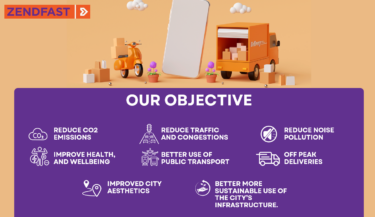Introduction
In recent years, the logistics industry has witnessed a significant transformation in the way goods are delivered to consumers and its impact on sustainability. With the rise of e-commerce and the growing demand for same-day deliveries, last-mile delivery has become a crucial aspect of the supply chain. However, this increased focus on efficiency and speed has resulted in environmental challenges, such as increased traffic congestion, air pollution, and carbon emissions. To address these concerns, the logistics sector is embracing sustainability practices to minimize its environmental impact. In this blog, we will explore innovative solutions and strategies adopted by companies to promote sustainability in last-mile delivery, ultimately creating a greener and more efficient future.

The Environmental Impact of Last-Mile Delivery
The last-mile delivery stage is often the most resource-intensive and environmentally impactful part of the logistics process. The following key factors contribute to its environmental challenges:
Increased Emissions: The high volume of delivery vehicles, often fuelled by fossil fuels, contributes significantly to carbon dioxide (CO2) emissions and air pollution.
Traffic Congestion: The surge in delivery vehicles navigating urban areas leads to traffic congestion, resulting in wasted time, fuel consumption, and increased greenhouse gas emissions.
Packaging Waste: The demand for quick deliveries has led to excessive packaging, generating significant amounts of waste that ends up in landfills or pollutes natural ecosystems
Promoting Sustainable Transportation
To mitigate the environmental impact of last-mile delivery, logistics companies are embracing sustainable transportation solutions. Here are several initiatives driving change:
Electric Vehicles (EVs): The adoption of electric delivery vehicles is gaining momentum. EVs significantly reduce carbon emissions and air pollution while offering cost savings in the long run. Companies like Amazon and UPS have invested heavily in electric fleets and charging infrastructure.
Micro Hubs and Consolidation Centres: By establishing localized micro hubs and consolidation centres, companies can optimize delivery routes, reduce the number of vehicles on the road, and minimize emissions. These centres act as central distribution points, allowing for efficient sorting and delivery planning.
Bike and Pedestrian Couriers: In urban areas, utilizing bicycles and pedestrians for last-mile deliveries not only reduces carbon emissions but also eases traffic congestion. Delivery companies like DHL and UPS have successfully implemented bike courier programs in select cities.
Crowd shipping and Peer-to-Peer Networks: Leveraging the sharing economy, crowd shipping platforms connect individuals and local couriers to deliver packages on their way to their destinations. This innovative approach maximizes existing transportation resources and reduces empty trips.

Collaboration and Data Analytics
To optimize last-mile delivery and sustainability efforts, collaboration and data analytics play a crucial role:
Collaboration between Stakeholders: Collaboration among logistics companies, retailers, urban planners, and policymakers is essential for designing efficient delivery networks, optimizing infrastructure, and developing sustainable urban mobility plans.
Data-Driven Decision Making: Leveraging advanced analytics and machine learning algorithms, logistics companies can optimize delivery routes, reduce empty miles, and improve vehicle utilization. Real-time data on traffic conditions, weather, and customer preferences allow for smarter decision-making.
Urban Planning and Smart Cities: City planners can create dedicated delivery zones, implement restricted access zones for traditional vehicles, and invest in smart traffic management systems to reduce congestion and improve delivery efficiency.

Conclusion
Zendfast is committed to sustainability in last-mile delivery is commendable. By embracing innovative solutions and collaboration, companies can reduce emissions, ease traffic congestion, and minimize packaging waste. Electric vehicles, micro hubs, and crowd shipping platforms are transforming the way deliveries are made. Sustainable packaging solutions and reverse logistics are reducing waste and promoting a circular economy. Moreover, data analytics and collaboration among stakeholders are driving efficiency gains. However, there is still work to be done. Continued investment in sustainable infrastructure, technology, and consumer education will be vital to achieving a greener and more sustainable last-mile delivery system. By prioritizing sustainability, the logistics industry can pave the way for a brighter future, where efficient and environmentally friendly deliveries become the norm.
